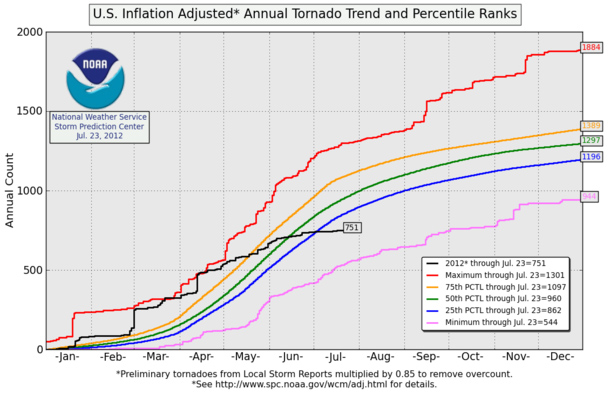July Could Set Record for Fewest Tornadoes


Update at 1 PM ET, July 27: There was one tornado in Elmira, N.Y. last night, according to preliminary data from NOAA, bringing the total for the month to 16 tornadoes. That's still well below the previous record. Tonight there's a 2 percent chance for tornadoes in three areas: South Dakota, Indiana/Ohio and the mid-Atlantic coast.
So far, this July there have only been 15 tornadoes reported throughout the United States, which is by far the fewest for the month since recordkeeping began in the early 1950s. If the twisters stay at bay, this month will shatter the old record of 42 tornadoes set in July 1960.
So what's causing the dearth of twisters?
"The one-word answer is drought," said Bob Henson, a meteorologist and science writer for the National Center for Atmospheric Research in Boulder, Colo. Fewer rainstorms means fewer chances for tornadoes, which only form in thunderstorms. "If you don't have thunderstorms, you can't get a tornado," Henson told OurAmazingPlanet.
Record drought has gripped much of the country, with nearly two-thirds of the lower 48 states in moderate to exceptional drought. Part of the reason for the drought — and hence the lack of tornado-producing storms — is the presence of a high-pressure "heat dome" over much of the country.
The year started out differently, with unusually high tornado activity. In March, for example, there were 151 tornadoes, well above average, Henson said. These deadly storms were the first billion-dollar disaster of the year.
But since drought has intensified in late spring and summer, tornadoes too have dried up.
Get the world’s most fascinating discoveries delivered straight to your inbox.
In many years, a large percentage of tornadoes occur on a handful of days, when conditions are right for twisters to form (such as strong upper-level winds and unstable air near the ground). This year was no different, with one-third of the year's tornadoes occurring on just three days: Feb. 29, March 2 and April 14 (when there were 153 twisters). [Infographic: Tornado! How, When & Where Twisters Form]
Prior to 2012, the three most tornado-starved Julys were 2002, 2006 and 2007. Both 2002 and 2006 were among the nation's warmest 10 Julys in the last century, just as this one is shaping up to be. When a summer month is unusually hot, it generally means the polar jet stream has been pushed well to the north by domes of high pressure. That means less upper-level energy to fuel tornado-creating thunderstorms. Non-tornadic storms (which rely less on wind shear and more on heat and moisture) may still pop up, assuming drought hasn't taken hold, Henson said.
Significantly more tornadoes can be recorded now compared with decades past, due to increased numbers of storm chasers and ease of sharing photos or video of twisters, Henson said, which would make this July record all the more impressive. Researchers have created "inflation-adjusted" stats that reflect how many tornadoes likely occurred in years past.
There may still be more twisters yet this month, though, Henson warned; in fact, severe weather in southeast New York could produce tornadoes this evening (July 26), and several tornado warnings just went into effect. But it seems unlikely that there will be enough to prevent the month from being a record-setting one.
Reach Douglas Main at dmain@techmedianetwork.com. Follow him on Twitter @Douglas_Main. Follow OurAmazingPlanet on Twitter @OAPlanet. We're also on Facebook and Google+.




